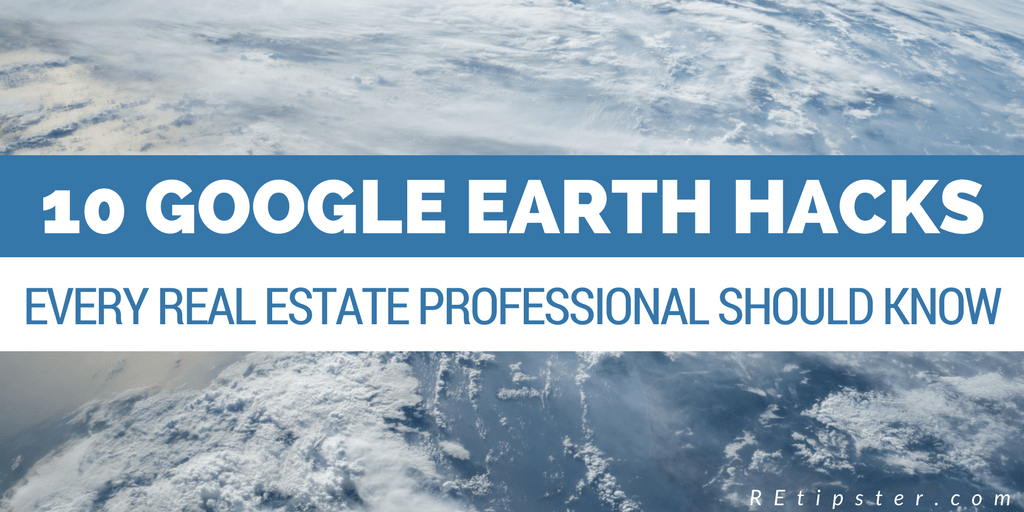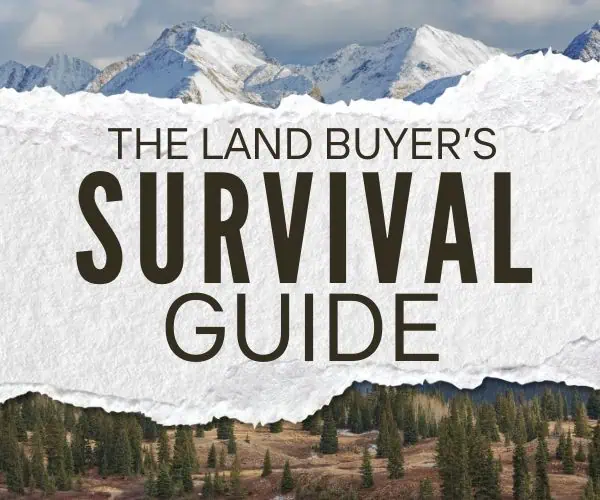
For as long as I've been in the real estate investing business, Google Earth has been one of the most helpful resources at my disposal.
Like most of the online tools Google has made available, it's 100% free – and considering everything this software can do, that's a pretty remarkable thing.

If you aren't already using this tool in your business – I'd like to show you ten quick examples of how I use it to research the properties I'm buying, compile the essential information I need in my due diligence process, and ultimately, get my properties sold.
1. Find GPS Coordinates & Directions
As a land investor, one of the inherent challenges I've always had is finding the precise location of each new property I'm working with.
Unlike the typical house or apartment building, most vacant land properties don't have a registered street address – so I can't just plug this into my GPS and get turn-by-turn directions to the property. If I want to know exactly where a property is, I need to find the exact coordinates on earth, and THEN I can figure out how to get there.
Luckily, Google Earth has an easy tool that can help me get the latitude and longitude of any location on earth. Once I've got this information, I can create a shareable link and text or email it to anyone who needs to know where the property is (and I can even generate a full-blown set of directions if needed). I'll show you how it works in the video below.
As you can see – it's pretty easy to get the job done once you know which steps to go through.
2. Measure Lot Dimensions
On many occasions, I've used Google Earth to determine approximate distances from one point to another. Why is this helpful? Because I can figure out how much road frontage a property has and/or what the dimensions of a property are. If you want to calculate the acreage or square footage a property is (in cases where the county doesn't help much in providing this information), this can come in handy as well.
Google Earth has a great little measurement tool that will allow you to measure these distances and dimensions very easily. I'll show you how it works in this video.
Remember, if you're going to give this information to any third parties or interested buyers, be sure to disclose that these measurements are approximate and it is NOT the same as getting a survey.
3. Draw Parcel Lines with the Polygon Tool
One of the many features I use in Google Earth is the polygon tool, which can draw a boundary overlay around any area on earth. There are all kinds of potential uses for this functionality, but I use it to draw lines to indicate where my parcels of land are located.
This is a great way to indicate where a property is situated AND to show what the terrain of that property looks like (whether it's flat, rolling, sloping, mountainous, in a valley, on a cliff, or otherwise). It's also great for indicating what is situated near or around the property. I'll show you exactly how it works in this video!
Note: It's important to remember that this kind of free-hand polygon drawing is NOT the same thing as a survey (because it's just your best attempt at indicating where the property lies on the ground). If you're going to use these drawings to show other people where a property is located, be sure to include a disclaimer that these lines aren't precise and that a survey should be ordered to be 100% certain about the boundaries and measurements of the property.
4. See a Property and Its Surroundings On-Site
If you're buying or selling a property remotely, Google Earth can be VERY helpful in getting you more familiar with the property's surroundings.
It's called Google Street View, and you've probably seen it before. This imagery isn't always current, but at most, it's usually a few years old – and if you've got no other way to see the property on-site, it can be a very helpful perspective.
Note: In the video above, I'm using an old software called AgentPro247 that no longer exists. These days, I'm using DataTree, which does most of the same things (and more) that AgentPro247 was capable of doing. You can learn more about it in this blog post.
As you can see, it offers a helpful view that goes far beyond what a simple satellite map would show. Even though the imagery isn't always current (like, within the past 12 months), I'd still MUCH rather be armed with this information than flying blind.
5. Research a Property's History
Another great thing about Google Earth is that in most areas, the satellite imagery is available for several years into the past – and you can use this historical imagery to see what the property looked like 2 years ago, 5 years ago, 10 years ago, 20 years ago and more (depending on what's available in your area).
Why is it helpful to see this far into the past? A couple of reasons immediately come to mind…
- It can help us understand whether or not a property is in the path of growth. If you zoom out to see the surrounding few square miles (or even the entire county) – you may notice that some new building and development has occurred over the past 10 – 20 years. On the flip side, you may also notice that nothing has changed. Either way – you should be able to draw some high-level conclusions about whether or not things are likely to grow in the coming 5, 10, or 20 years.
- This historical satellite imagery can help us understand what activities may have taken place on the property in the past and/or what that property was used for. Has it ever been contaminated? Did it use to look better or worse than it currently does? Has the timber been harvested recently? Has this property improved or deteriorated over time? Chances are – if anything dramatic has changed in the past decade or two, the historical satellite pictures will help tell you the story.
The availability of historical map data varies based on what parts of the world you're looking at – but chances are, you should be able to find SOME historical imagery through this helpful functionality in Google Earth.
6. View a Property's Terrain and Topography
When you're buying vacant land, something you should be fully aware of is the terrain and topography of the property in question (and this becomes increasingly important when you're investing in areas known for hills, valleys, mountains, ravines, and the like).
There are MANY places in the world that have unpredictable elevations, cliffs, mountains, valleys, and more. In many cases, the topography of the land can have a major impact on the build-ability of the property itself. For the same reasons you can't build a house on a vertical cliff, you should always do some preliminary research to find out where your property is located and what the lay of the land is.
As you can see, these free resources (Earth Point and Google Earth) can provide some VERY important information that you'll want to know about before you commit to any new property (and if you're willing to pay for a subscription, Parlay can also be quite helpful in identifying parcel lines).
RELATED: What Is a Topographic Survey?
7. Find the Elevation of Any Point on Earth
If you're working with properties in an area of the world that are high above sea level, something you (or your future buyer) may be wondering about is what the elevation is of the property in question.
Google Earth makes it ridiculously easy to get this information by simply hovering your cursor over whatever point on earth you're looking at. I'll show you how it works in the video below.
Pretty slick, huh?
8. Record an Informational Video
When it comes time to sell a property – videos can be an extremely helpful way to explain the value behind a deal.
Of course, one way to create a video is to shoot and edit a highly produced, on-site virtual tour and show people exactly what the property looks like… but if you can't justify the time or money to create this kind of production, another option is to simply use Google Earth and record a screenshot tour – narrated by yourself (the software I recommend for this purpose is Camtasia, and it's pretty easy to use).
Someone who does a great job of these kinds of videos is Luke Smith of RuralVacantLand.com. Here's a quick example of what his videos look like…
As you can see, it doesn't have to be a flashy presentation with cool effects and music in the background. You also don't have to stick with only Google Earth. You can also show your website, Zillow, or any other online resource that helps explain the narrative.
The value isn't necessarily in the fancy production; the value is in the information you provide and the basic selling points behind the property. If you follow a standard descriptive procedure like this (covering all the same basic points and views of each property and its surroundings), it's not hard to create a powerful and effective promotional video with Google Earth.
9. Import KMZ and KML Files for Property Research
If you've learned to use all of the free features of Google Earth and want to take a HUGE new step to expand the usefulness of this software – you ought to know about KMZ and KML files. A KMZ file (a collection of KML files) can add new layers to the map to show buildings, illustrate power grids, rivers, image overlays, parcel lines, and much more.
As a land investor, I find these files particularly useful for identifying the parcel lines of the properties I'm buying and selling. One way to get this information to show up on Google Earth for most of the United States is to use a service called Parlay. I'll show you how it works in the video below…
As you can see – this subscription imports data from thousands of counties across the U.S. Most notably, it will show you parcel lines and owner information (including mailing addresses). In some cases, it will show you transfer values, market values, acreage, and much more. It's a SUPER helpful tool that is easy to justify if you need this information on a somewhat regular basis like I do.
10. Create 3D Polygons to Identify Parcels
If you're dealing with a vacant land parcel or any other type of property where the size, shape, and dimensions are difficult to visualize relative to its surroundings, you can go one step further by creating a 3D polygon that makes it nearly impossible to get confused about where the property is situated.
And don't forget, once your parcel is created, you can save the KMZ file and share it with others, so it's very easy for others to see (on their computers) where the property is located.
11. Google Earth Studio (BONUS)
If you're trying to showcase or sell a property, one of the coolest (and totally free) tools you can use for this is Google Earth Studio.
This is an amazing way to get drone-like videos and images of your property without leaving your computer! I'll show you how it works in this video.
Head over to Google Earth Studio now and give it a try! It may take a bit of time to get familiar with the software, but once you get over the initial learning hump, this is a great way to show off your properties in a way that's fast, easy, and looks great.
What Else Can Google Earth Do?
Google Earth can do much more than what I just showed you in the points above… these are some of the simpler functions and features that are mostly free and easy to use.
It's worth noting that Google has recently moved the software to a format that functions within the Chrome internet browser – which brings about some improvements in some areas (most notably, speed and appearance). However, I've also found that it has taken some notable steps backward in other areas (mainly in features and functionality).
I prefer the desktop version of Google Earth because it offers A LOT more useful applications to real estate professionals. If this is the version you're after, you can find it on this page.










